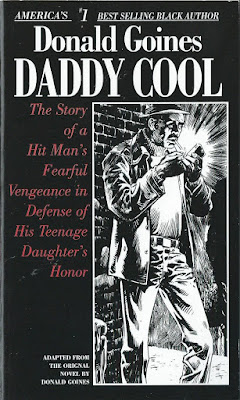Book Review: 'Daddy Cool' by Donald Goines
Graphic Novel adaptation by Don Glut (script) and Alfredo Alcala (art)
celebrating Black History Month 2016
Here at the PorPor Books Blog, we like to celebrate Black History Month by reading a book - fiction or non-fiction - that illuminates the Black Experience.
For Black History Month 2016, we're looking at the graphic novel of Donald Goines's 1974 novel Daddy Cool.
I first learned of this unique little book when a post about it appeared at the Museum of Uncut Funk website.
(The Museum of Uncut Funk is definitely a site to visit and bookmark, especially if you are a fan of black popular culture of the 70s).
The Daddy Cool graphic novel was published in 1984 by Holloway House, a small press company devoted to publishing the works of Goines and other black authors.
The graphic novel is a black-and-white, mass-market-sized paperback. There obviously are problems with adapting the artwork to this format. Those pages with just one or two panels will have a low-res, Ben-Day-dot appearance, while others with several panels are much more legible.
Overall, however, the high quality of Alfredo Alcala's artwork impresses.
'Daddy Cool' opens in Flint, Michigan......it's the early 70s, and the water is safe to drink. But Flint is still a gritty, low-down industrial town, and Larry Jackson - aka Daddy Cool, ace hitman - is there to take care of some business.
Daddy Cool prefers to work with knives, which he throws from close range. Daddy Cool is careful and methodical when he's on the job, knowing that the slightest mistake can earn him the electric chair.
Off the job, however, Daddy Cool is prone to losing his temper. He don't take shit from anyone, least of all his beautiful, but headstrong daughter Janet; his wife Shirley; and her sons, Jimmy and Buddy.
After a particularly heated confrontation with her father, Janet decides to run away from home and live with her boyfriend Ronald. But Ronald, as it turns out, is not the man she thought he was when she was dating him. For Ronald is a cruel and self-centered pimp.....and Janet is to be his ticket to easy street.
Daddy Cool decides that the best course for Janet is to receive Tough Love, in the form of a harsh education in the reality of the streets. But as the days go by, and Janet sinks ever deeper into degradation at the hands of her boyfriend, Daddy Cool will have to take action....violent action.....before Janet's humiliation is avenged.......
This graphic adaptation of Daddy Cool is by no means a comic book aimed at a juvenile readership; to the contrary, it depicts R-rated, Straight Up, Unapologetic Ghetto Action, which is precisely what Donald Goines hoped to achieve with his novels. If you are a fan of black writers like Goines, Chester Himes, Iceberg Slim, and Nathan C. Heard, then you'll want to pick up this graphic novel version of Daddy Cool.

































































.jpg)


















